DOI:10.32604/iasc.2021.018914

| Intelligent Automation & Soft Computing DOI:10.32604/iasc.2021.018914 |  |
| Article |
Development of a Web-Based Telemedicine System for Covid-19 Patients
1Electrical and Computer Engineering Department, North South University, Dhaka, 1229, Bangladesh
2Department of Information Technology, College of Computers and Information Technology, Taif University, Taif, 21944, Saudi Arabia
3Department of Computer Science, College of Computers and Information Technology, Taif University, Taif, 21944, Saudi Arabia
*Corresponding Author: Mohammad Monirujjaman Khan. Email: monirujjaman.khan@northsouth.edu
Received: 26 March 2021; Accepted: 19 May 2021
Abstract: In the Covid-19 pandemic, people have been very concerned about the safety and are avoiding crowded places like hospitals. An online telemedicine web-based technology can help to overcome this situation. This paper presents an online telemedicine system that helps to promote collaboration between doctors, hospitals, and patients. The system allows doctors to serve patients from remote areas. The system also allows both doctors and patients to communicate through video calls or text messages. Patients using the system can store information about their health, search for doctors, and consult medical professionals using text messages and video calls. Doctors can also register to serve patients, but they must ensure authenticity through registration. Doctors can write blogs, provide prescriptions, and can view the medical history of the patient. Hospitals can assign doctors in the respective departments. The system is tested in a lab environment. The system is fast and reliable with a user-friendly interface, enhancing telemedicine services countrywide for people with online access.
Keywords: Covid-19; online telemedicine; web application; text message; video calling; google map; payment gateway; twilio
Telemedicine allows doctors to serve patients remotely through technology. It requires electronic messages and applications to provide patients with healthcare without an in-person visit. This service can be used for follow-up appointments, drug management, the provision of expert advice, and various other health services via secure video and audio communications [1]. In the current Covid-19 pandemic situation, telemedicine is one of the most important platforms to provide healthcare services.
A web application is a program that makes use of web browsers and web technologies to perform web activities. Web applications use a mix of server-side scripts to manage information storage and retrieval and client-side scripts to provide useful information [2].
Bangladesh is an overpopulated country, where finding a doctor to provide appropriate treatment is challenging [3]. An estimated 10 million people in Bangladesh have diabetes, and almost 1 in 10 adults in Bangladesh are diabetic [4]. A study showed that around 30%–35% of the population in Bangladesh suffers from heart diseases [5]. In 2017, the Bangladesh Health Facility Survey revealed that more than 70% of rural healthcare facilities do not have all six necessary needs [6]. First, very few specialized doctors are available for the sizeable population. Second, it is challenging to receive proper treatment because there are very few treatment options due to the absence of specialized hospitals or doctors in many areas, especially in rural locations. People travel to cities, like Dhaka, for better treatments, which can be costly and time-consuming. The traffic and road conditions are poor, which also hinder people from receiving proper treatment. Patients may have to wait for a month or two to get an appointment with a doctor. In emergencies, it is hard to obtain proper treatments on time, which in many cases leads to fatalities.
In Bangladesh, there are an estimated 3.05 physicians per 10,000 population and 1.07 nurses per 10,000 people (estimates based on Ministry of Health & Family Welfare, Bangladesh Secretariat, Human Resources Development Unit, 2011) according to the “World Health Organization (WHO). About 28% of the treatments provided in government health facilities comprise alternative medicine [7]. Infectious diseases are a major cause of death and disabilities in Bangladesh [8]. The healthcare system of Bangladesh largely relies on the government or the public sector to manage and develop general strategies and service delivery structures [9]. The country currently has only six doctors for every 10,000 citizens. This is problematic because about 64% of the population reside in rural areas and face difficulties accessing healthcare services [10]. Moreover, due to this shortage, people face very long queues at healthcare facilities, and each appointment’s duration is limited.
A study on human resources in the healthcare sector describes the challenge. Bangladesh still has a significant shortage of more than 60,000 physicians (currently 31,000 physicians) and has only around 140,000 nurses [11]. Bangladesh has one of the worst nurse-physician ratios. The study concluded that almost 80% of communities in the country are still finding their first line of care from informal health care practitioners who are conventional healers, faith healers, and community health workers [12]. In the current healthcare systems, absenteeism, inefficiency, and corruption are also seen (Brac University, 2009; New Age 2008). In addition, 90% of children suffer from acute respiratory infection or diarrhea [13]. Bangladesh, therefore, has a shortage of over 60,000 doctors and 280,000 nurses [14].
Telemedicine is a much-needed service for most people. However, sometimes, individuals face problems when they directly visit a hospital. The more common issues are time-consuming traffic jams, poor conditions of roads, unavailable transport, the critical situation of the patient’s health, difficulties due to a large number of people, and constraints due to the coronavirus pandemic.
The COVID-19 virus is currently spreading rapidly in all areas of Bangladesh [15]. As a result, the government has closed schools, colleges, and many others. Telemedicine and telehealth technologies are highly effective in pandemic situations when health officials consider implementing social distancing programs [16]. Online telemedicine services are, therefore, needed.
Online telemedicine service is not a new concept. Many telemedicine services exist worldwide, including some that are particularly renowned. Developed countries had introduced telemedicine over the past decades and have utilized these services to serve their patients countrywide effectively.
Practo works as a gateway for doctors. It allows users to book medical appointments or consultations at hospitals, obtain insurance, store health records, or prescribe medicines through its mobile applications and website to seek medical assistance via video calling. In addition, patients can quickly consult with a doctor and receive prescriptions [17].
Lybrate is a healthcare and delivery service system. It helps the patient to connect with doctors. After successful registration, users can manage their accounts. They can make an appointment with a specialist doctor based on their preferences and consult with the doctor via video calls. It offers a wide range of services to both patients and doctors [18].
Medlife serves the health needs of patients with online consultation and health record storage services. The system also includes online digital payment through a partnership with another service. In addition, patients can consult with a doctor via video-calling after booking an appointment [19].
MeMD offers users an easy way to establish an account. After the account is activated, the patient can contact a nurse practitioner or physician directly via webcam. In addition, patients can consult with a doctor from any place via video-calling [20].
MDlive is an online telemedicine service provider in the USA. It helps the patient to find a doctor from any location and provides 24/7 healthcare services through its websites. Patients can easily connect with the doctor using the system via video calls. In addition, doctors can deliver prescriptions to patients according to the healthcare needs [21].
The first telemedicine system emerged in Bangladesh [22] in mid-1999. To date, there do exist some online telemedicine services in Bangladesh.
iClinic is a medical second opinion platform where users can get medical advice from doctors. A patient can consult with professional doctors through an appointment and interact with the doctor through video-calling [23]. However, the user interface is not user-friendly, and the service needs improvements.
Telemedia is a system that offers a blood test and treatment. Here, a patient can consult with a professional through chat. They choose a relevant specialist after the information has been collected. Following an appointment, a patient can consult a registered doctor through video-calling and text messages [24].
The Tonic Doctor system provides a platform for telemedicine services. Patients can consult a doctor over the phone and via video calls after an appointment [25]. However, the system is not user-friendly for general use.
Daktarbhai is a telemedicine system that provides online-based doctor appointment services. Patients can consult a doctor through video calls and store their personal health information. Patients can also monitor their day-to-day health conditions [26]. The system response time is relatively low.
The Sebaghor system helps to find a list of doctors and hospitals. A patient can subsequently make an appointment with the doctor they prefer. There are three registration types: one can register as a doctor or as a patient or hospital. Patients can connect with the doctor through video-calling [27]. However, there are no emergency services offered, and most people find the service charge to receive a treatment high.
Some telemedicine services also exist in towns, but they provide services that need improvement in most cases. Most of the interfaces are not user-friendly, while some of them are not affordable for most people. They also have no emergency services. These constraints re-emphasize the need to develop a user-friendly web-based system. Such a system should be very fast and reliable in comparison with other telemedicine services. Ideally, it should also provide 24/7 emergency consulting services with a qualified doctor through text messages and video calls.
The remaining sections of this paper are as follows: Section 2 discusses the methods and methodology; Section 3 presents the results and analysis; and in Section 4, the conclusion is provided.
The Twilio Application Programming Interface (API) is used to develop a video-calling system. The SSLCOMMERZ API is used for the payment gateway. In Bangladesh, SSLCOMMERZ is the payment gateway for merchants to collect payments on the internet. Clients can purchase products online using credit cards and bank accounts [28]. The Google Map API and Google Geocoding API are used here to determine the location of doctors. Ajax and JavaScript are used for real-time text messaging. Structured Query Language (SQL) and Hypertext Pre-processor (PHP) have been used for databases and database connection. HyperText Markup Language (HTML), Cascading Style Sheets (CSS), JavaScript, and Bootstrap have been used for the front-end design.
The entire block diagram of the proposed web application is shown in Fig. 1. The web application helps people to consult with a specialized doctor for remote treatment.
The online telemedicine system consists of three user roles and administration. A user can sign in as a patient, doctor, or hospital. Patients can access the doctor lists, search for doctors after registration, and make an appointment with a doctor through video calls from remote areas.
Patients can also interact with the doctor via text messages and voice calls and store and edit their medical information in the system. A doctor can access the medical history of any patient. Doctors can also provide prescriptions to their patients. A hospital can add doctors and their departments after registration to ensure authenticity. An administrator can manage all the data available in the system and can accept or reject user registration. A user profile is automatically created by the system for every user based on the information provided by the user during registration. If needed, they can update information.

Figure 1: Block diagram of proposed online Telemedicine System
2.2 Entity Relationship Diagram
The entity-relationship diagram, which portrays the structure of the existing system database, is shown in Fig. 2. It shows how entities, like a patient, doctor, hospital, blog, department, or administration, are connected.

Figure 2: ER diagram of the telemedicine system
The use case diagram depicting the characteristics of the telemedicine system is shown in Fig. 3. It represents the interaction of the user with the system.
2.3.1 Use Case Diagram for Patients
In this web-based application, patients from remote areas can interact with a qualified doctor. They can consult a doctor through video calls and interact with the doctor through text messages and voice calls. In addition, patients can view the complete list of doctors and search for doctors. In case of an emergency, they can also consult doctors at no cost through our emergency service.
2.3.2 Use Case Diagram for Doctors
Doctors can easily connect with patients using the telemedicine application. A doctor can provide treatment and diagnose patients through video calls from remote locations. Doctors can also write and maintain a personal blog to help patients learn about essential healthcare. A doctor can also provide prescriptions to patients according to their needs and consult the patient’s medical history.
2.3.3 Use Case Diagram for Hospitals
Hospitals can add a doctor to the existing list of doctors to better treat their patients through the telemedicine web application. A hospital can add the doctor department-wise, which helps patients to find their doctors easily. Hospitals can also monitor the appointment of doctors.
The web application is connected to a database. The database contains many tables to store data and to connect it with the website. All data issued for users, doctors, and hospitals can be reserved by the website and observed via the administration panel. The site is fully secure, and only the administration panel members can check and verify users’ information. In addition, registered users can check their activity history, which is required to maintain the database. The database has been developed using Php My Admin and MySQL.
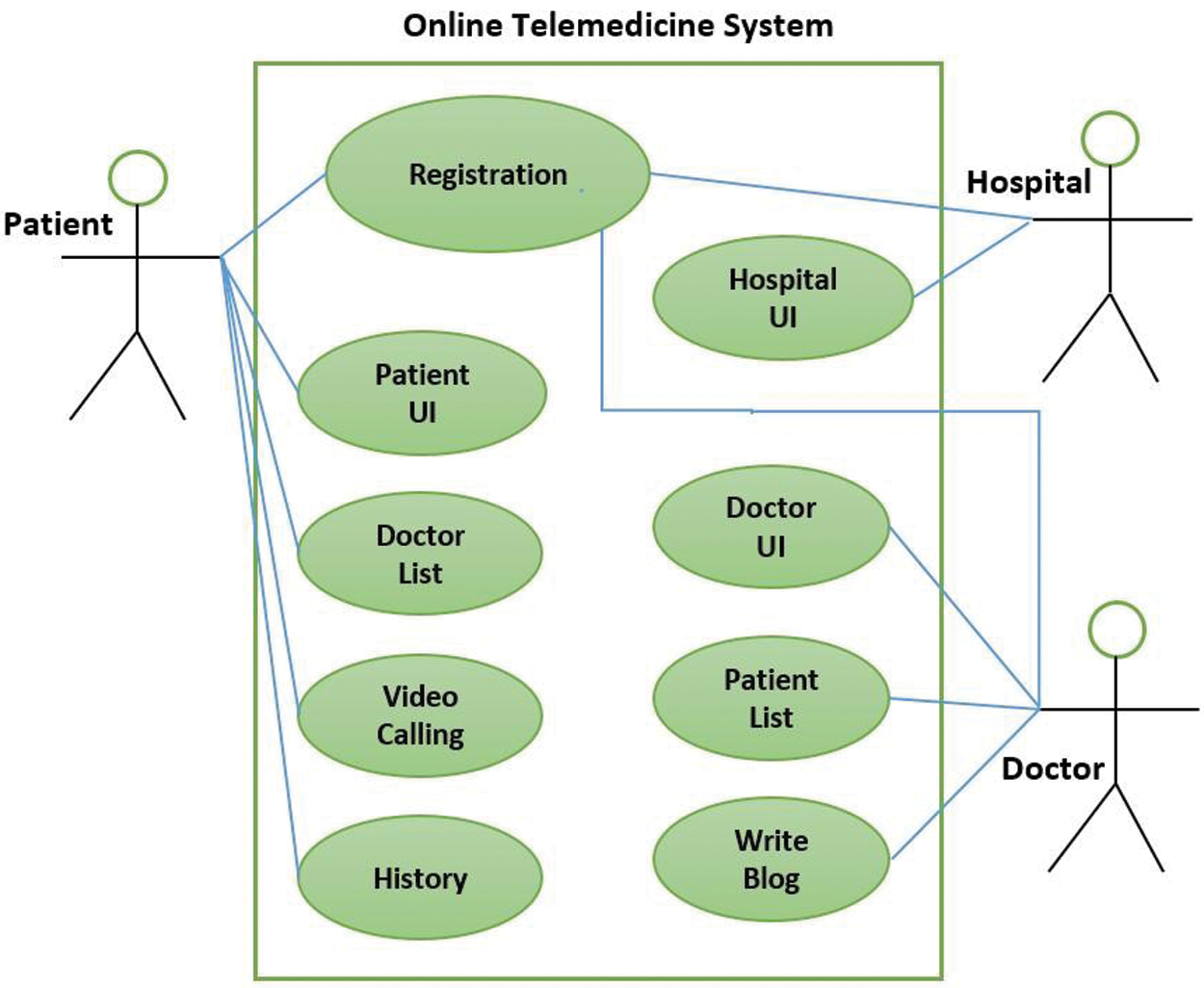
Figure 3: Use case diagram of the telemedicine system
3.2 Web Application Functionalities
The web application has been developed using HTML, CSS, JavaScript, and Bootstrap. PHP was used for the database connection.
The opening page of the website is shown in Fig. 4. Users can view the doctors, hospitals, departments, and patients as a count on the opening page without logging. The page allows anyone to see the content. If one finds a service of interest, the user can create an account for further activity. One can also view the blogs and frequently ask questions through this landing page. It is the most important web page because all other services are provided mainly from this page.
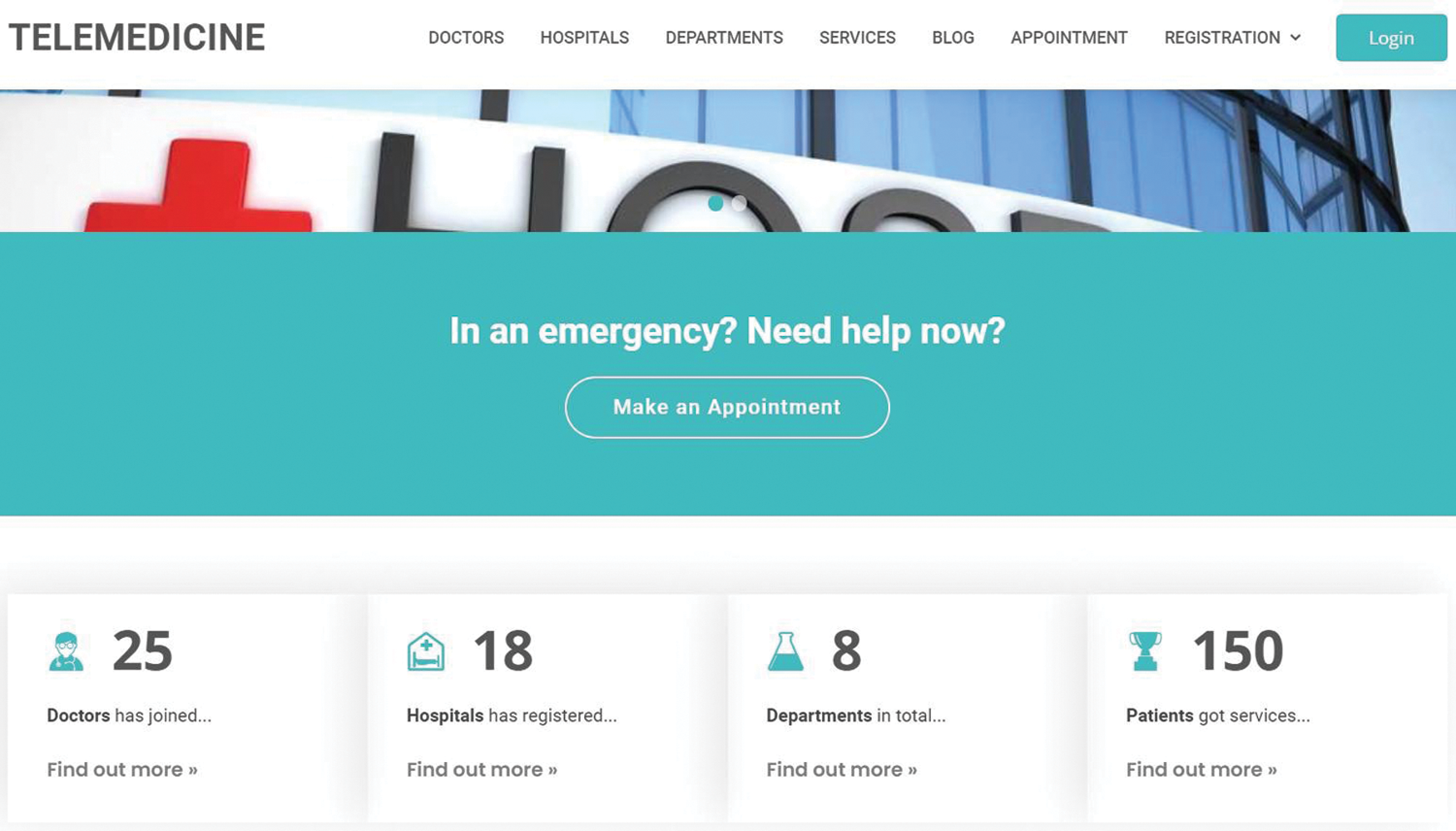
Figure 4: Landing page of the proposed web-based telemedicine system
The log-in page is shown in Fig. 5. Users can use the telemedicine service by operating the user interface for applications. If the user provides the wrong username or password, the login process fails. The system also provides the option to obtain a new password if the original one has been forgotten. The users must provide some information to validate their registration. If there is an information match, they can change their password and log in to the user interface.
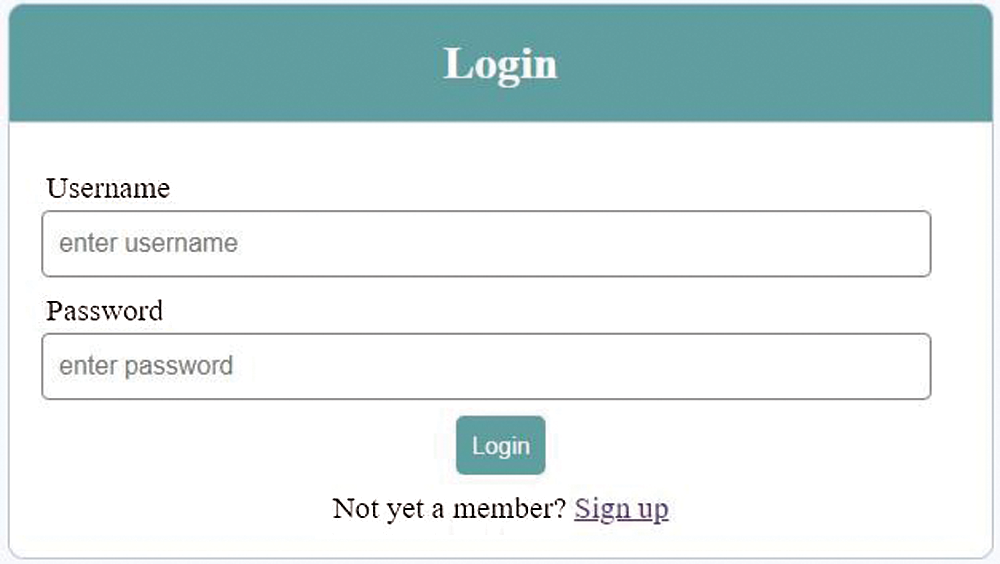
Figure 5: Login page for users
Hospitals must be registered via the website, and the registration process is the same as that for patients and doctors (Fig. 6). Specific information is needed for registration. For patients, a verification code is sent to the email provided by the user. Users must provide the correct code to confirm the registration process. For doctors and hospitals, registration numbers are verified via the administration panel. A doctor or hospital registration is complete only after confirmation by the admin.

Figure 6: Registration page for hospital
The patient user interface (UI) is shown in Fig. 7. It has been designed so that patients can view the full list of doctors, hospitals, and departments. After a successful login, users can search for a specific doctor by name for quick action, make an appointment with a doctor, see medical history and health information, and connect with a doctor via text messages and video calls. Prescriptions made by doctors are available to users, which can also be downloaded and printed for further use. All essential information is stored automatically after every service usage. Users can also avail free emergency services via the web application.
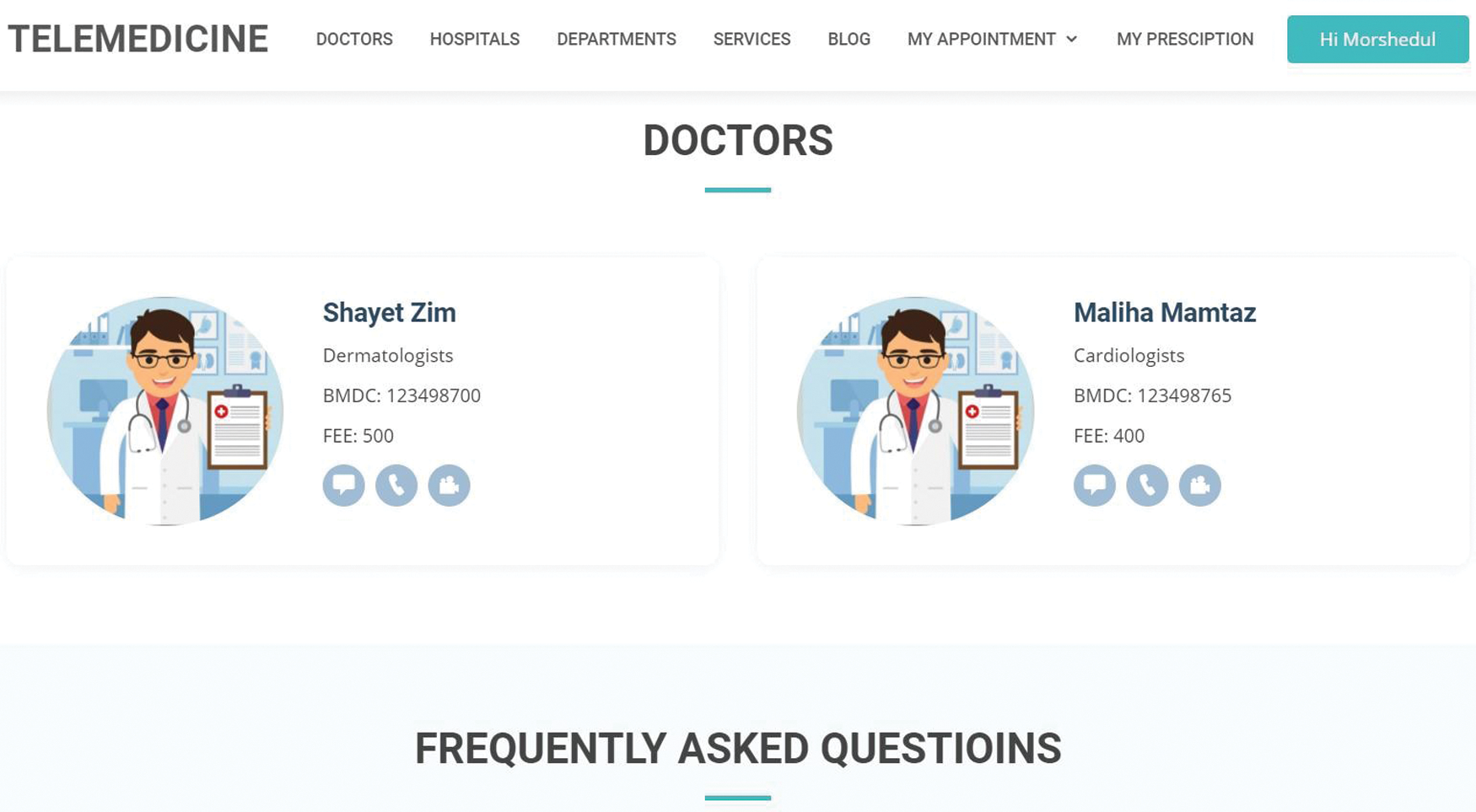
Figure 7: Patient user interface
The doctor UI is shown in Fig. 8. The interface has been designed so that doctors can view their patient lists, upcoming appointments, personal blogs, and the medical history of patients. If needed, they can contact a patient for further treatment through video calls or text messaging. In addition, a doctor can make prescriptions and can also write blogs. Blogs are open for viewing by users.
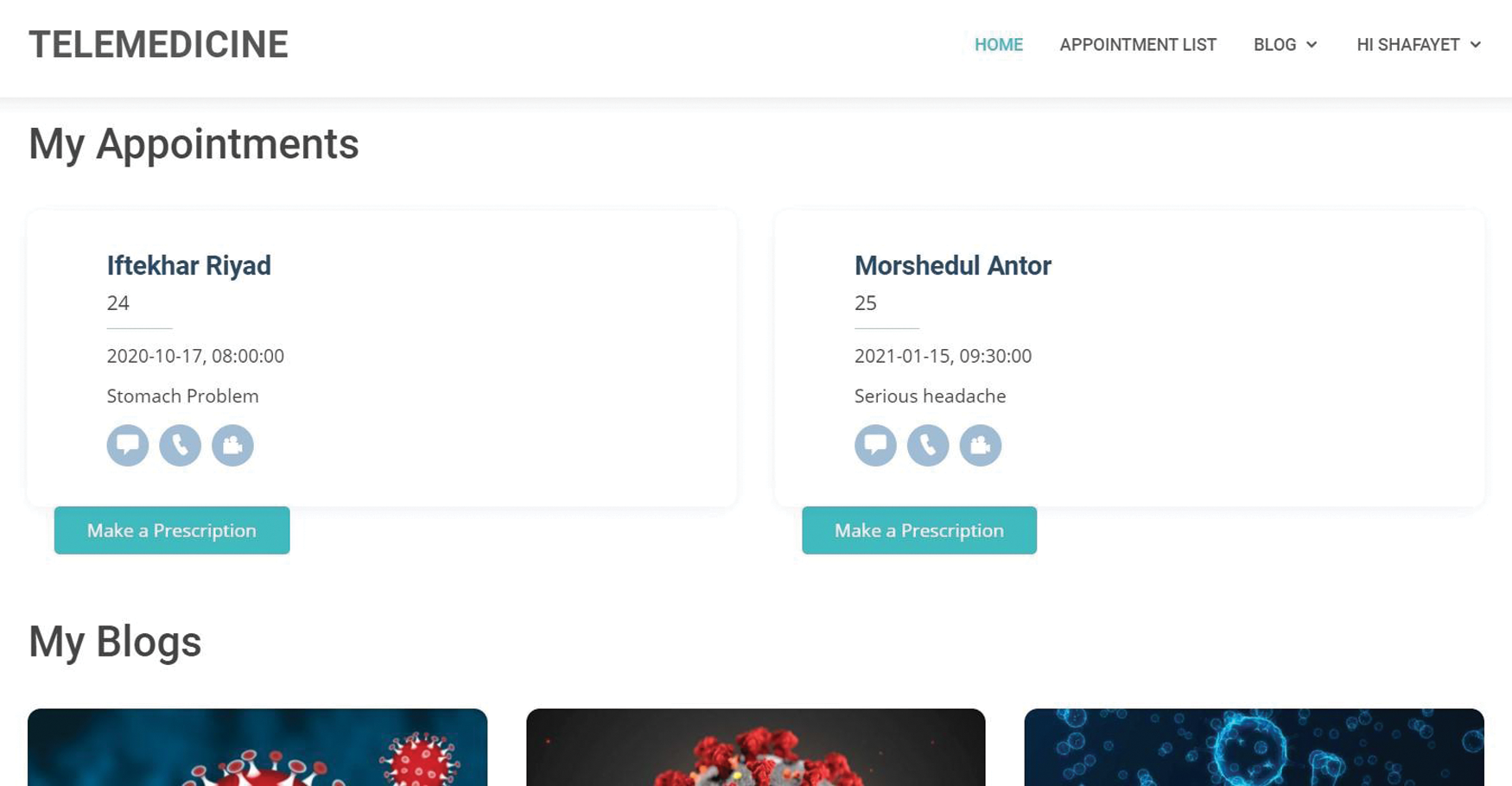
Figure 8: Doctor user interface
The add doctor process from the hospital end is shown in Fig. 9. The hospital UI has been designed to regulate the telemedicine services mentioned hereafter from the hospital user end. The hospital can view the list of all doctors. If any doctor is to be added to their service, the “doctor addition” step is needed. The hospital can view all their patients and their assigned doctors. It can also view the prescriptions given by each doctor and can manage text messages and video calls. The hospital can also write blogs on its behalf.

Figure 9: Add doctor from hospital user interface
The blog writing process is shown in Fig. 10. Users can receive relevant information from blogs. Any website viewer can see the blogs, but hospitals and doctors can only see their respective blogs. The blog page is designed in such a way that doctors can quickly write and manage blogs. Hospitals can also write blogs. In the blog, hospitals can include relevant content and attract new clients.

Figure 10: Doctor writing blog
The appointment process is shown in Fig. 11. Appointments are needed to avail healthcare services. It helps to provide services on time. Users can know the time and date of consultation when making an appointment. They can log in and interact with the doctors through text messages or video calls on the appointment date. Patients can also make an appointment with a doctor after registration and can choose a doctor. They can select their preferred doctor after choosing a department. Patients can also decide on the meeting platform to connect with the doctor through a successful appointment system. Payment is needed for a successful appointment. Otherwise, the appointment will be canceled automatically after a specific time.
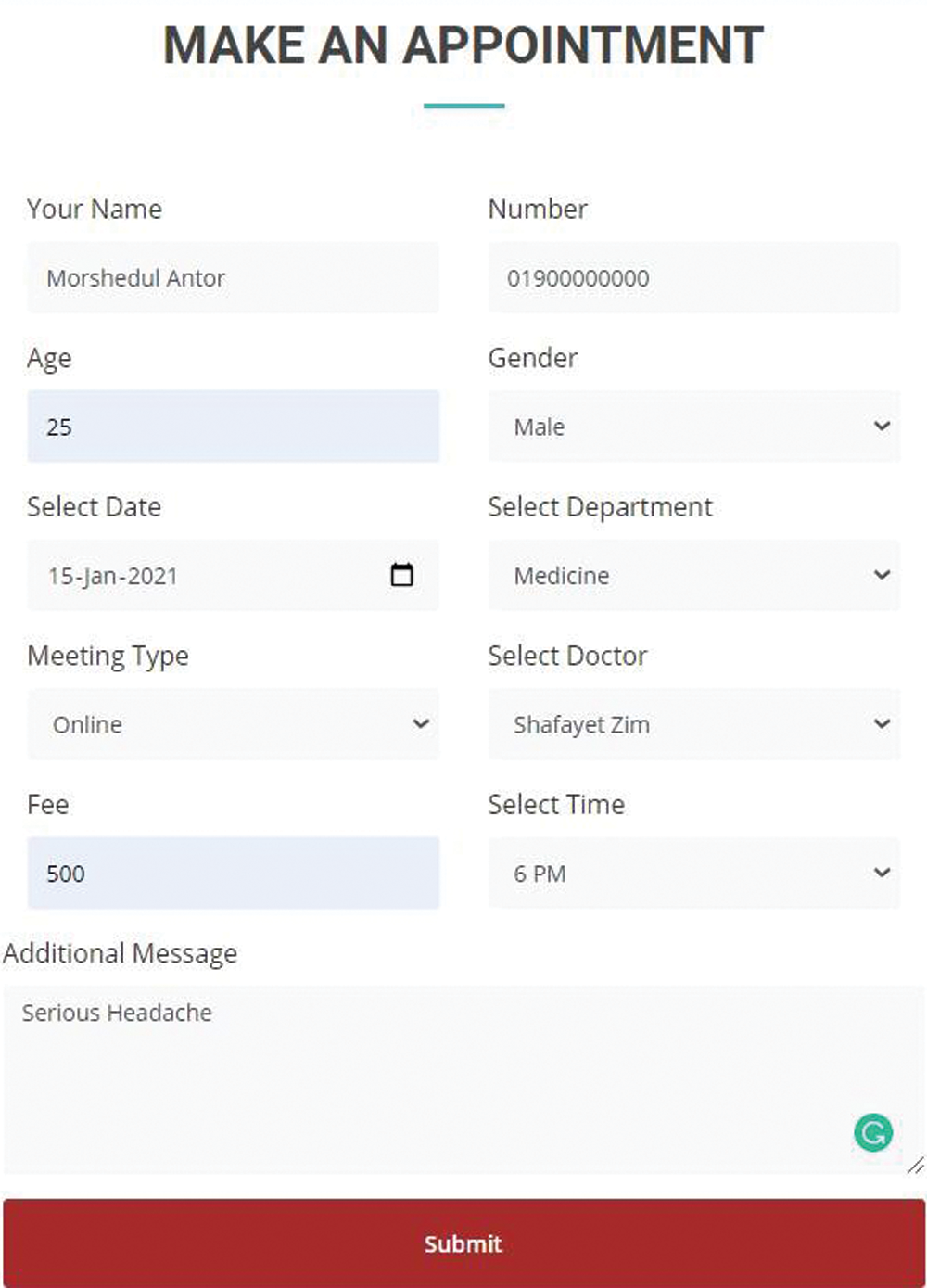
Figure 11: Make an appointment with a doctor
Users can avail of emergency support when needed (Fig. 12). The service page has been designed to include emergency help, like audio calls, video calls, and ambulance service. Video calls are needed when patients cannot visit a hospital or a doctor’s clinic but need immediate help. They can contact doctors directly. If they need to see the patient, the doctor can do a video chat with the patient. The system also provides a messaging service. The lack of proper medical advice could potentially lead to severe impairments or fatalities. If patients can get helpful information, it may help them to survive a critical moment.

Figure 12: Emergency services
Patients can chat with a doctor when the doctor is online after booking an appointment (Fig. 13). They can ask questions about their health through real-time text messages. If a user, for some reason, is unable to interact with the doctor via video calls, they can easily make contact through text messages. In cases where the network is not stable, text messaging is more efficient. Communication with doctors is easier because text messages do not need to require high internet speed or strong network connectivity.
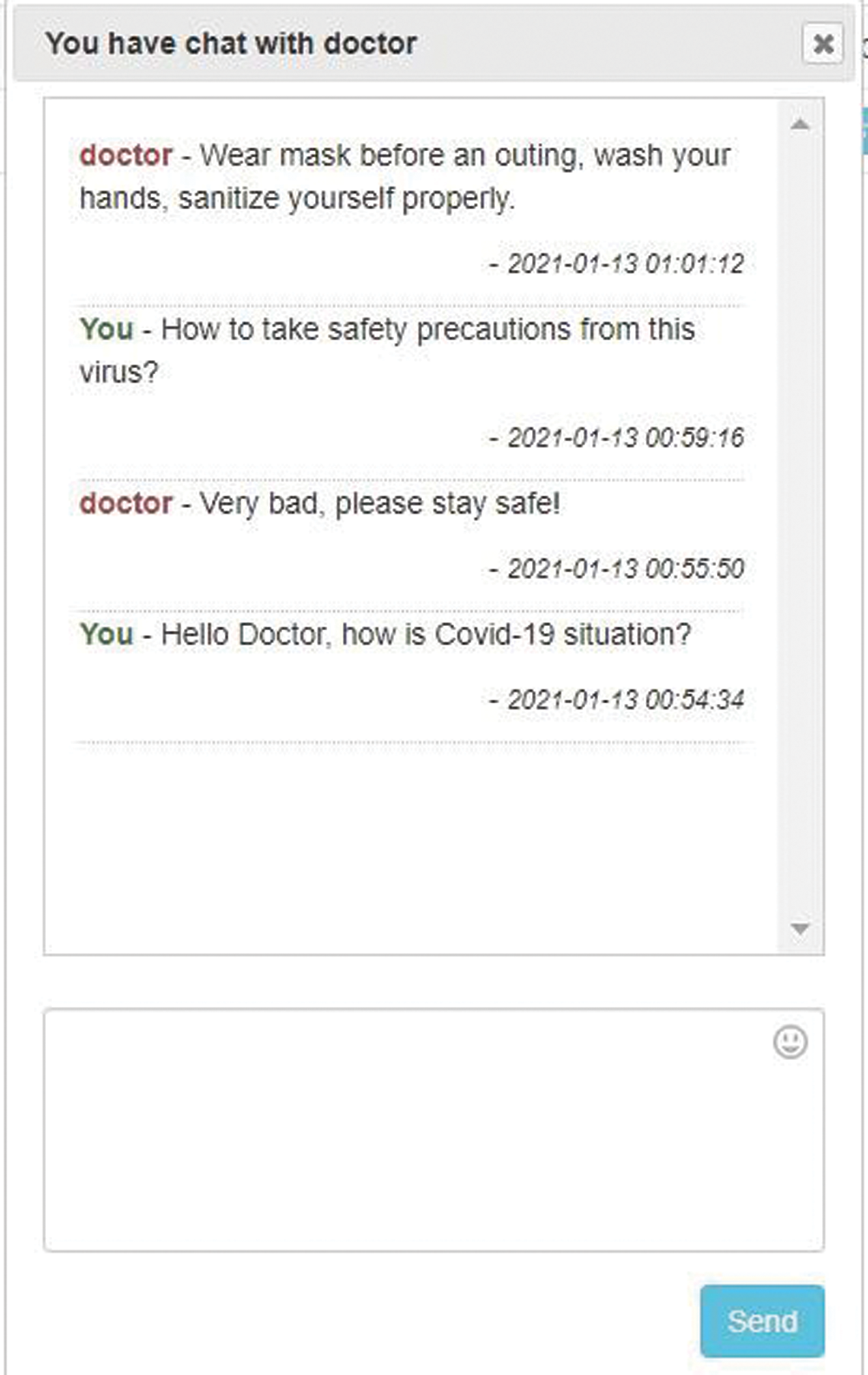
Figure 13: Chatting with doctor
The video-calling process is shown in Fig. 14. Video calls are usually used for meeting purposes. Doctors need to see their patients for better treatment. Patients can connect with a doctor through video calls after booking an appointment. On the appointment date, doctors will create a room, and patients must join that room before they can meet each other. Doctors can quickly review all the health-related concerns of a patient and consult via video calls. The Twilio Application Programming Interface (API) has been used to develop this video call system. Twilio is an API that offers various kinds of services. It supplies rest APIs and software APIs for developers to interact with or make video calls or immediately synchronize data between two customers. It allows video calls to be conducted through web applications [29].
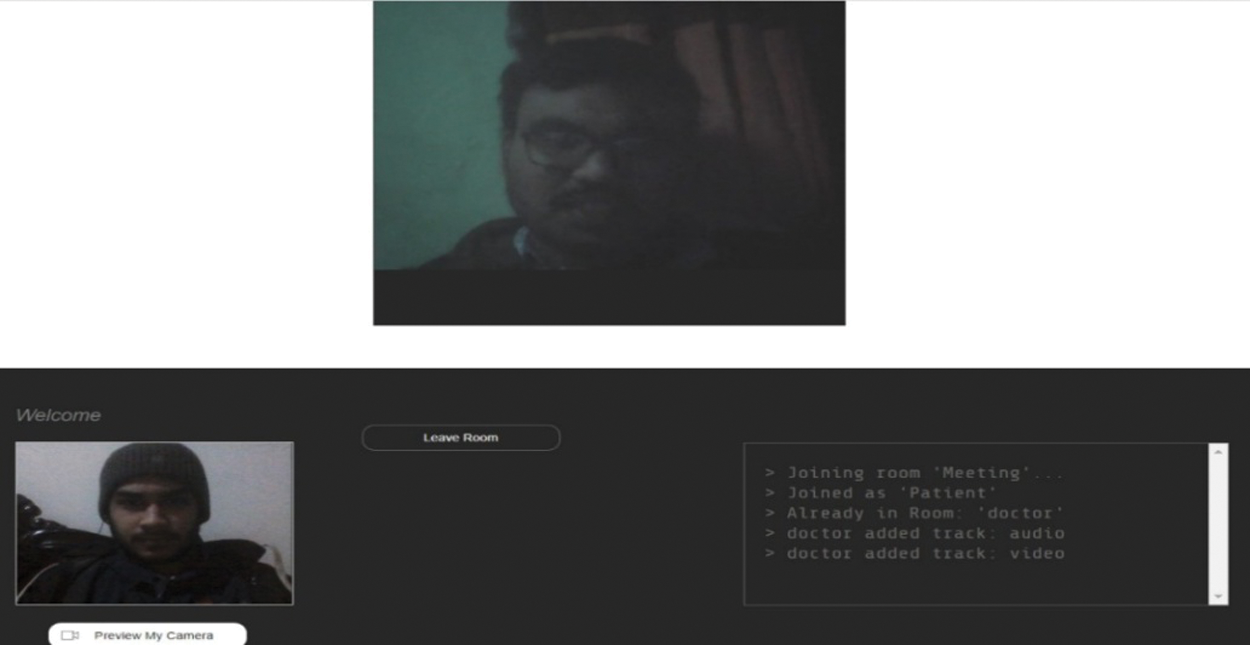
Figure 14: Video calling system
The administrator can manage user data from the administration panel interface (Fig. 15). Only specific members declared as an administrator can log in to this system. By logging into this interface, the administration panel will verify the registration of the doctor. Only after the signing in the process of the doctor is completed will the hospital registration take place. A doctor can be removed at any time from the administration UI if they do not comply with the system policy, and a new doctor can be added. The administration can also add or remove any hospital and check the hospital list with essential details.

Figure 15: Admin user interface
Doctors can provide prescriptions as PDF files (Fig. 16). PDF is the most useful format for storing composed data. An FPDF API has been used for the PDF service. Doctors can write prescriptions, and the reports are converted to PDF format automatically. Patients can view the prescriptions provided by their doctor on the web application. Patients can easily download the PDF of the prescription and can send it via email or print it out.

Figure 16: Prescription PDF
The payment gateway for patients is shown in Fig. 17. Patients can easily book an appointment with a doctor after successful payment. There are various payment options, like debit or credit cards, mobile banking, and internet banking. The prescription or consultation fee per session depends on the qualification and specialization of the doctors. The consultation fee varies from 300 Bangladeshi Taka to 500 Bangladeshi Taka. The SSL COMMERZ API was used for the development of the payment option.

Figure 17: Payment gateway
Patients can view a doctor’s location using the Google map, as shown in Fig. 18. The map allows users to find doctors from the map. The Google map API and Google Geocoding API were used for the development of the map. The Google Geocoding API automatically takes the address of the doctor from the database, calculates the latitude and longitude, and puts the marker on the map with the name and specialty of the doctor. Users can customize the view option according to their preferences. As a result, the map shows the location of the doctors accurately.

Figure 18: Doctor location from Google Map
In Bangladesh, the availability of healthcare is one of the significant challenges. Few qualified doctors serve the population. In many cases, people wait for a long time to consult qualified doctors, and this service is also very costly. In this paper, a web-based online telemedicine system is presented. The web application allows users to connect with the desired doctors, permits doctors to make prescriptions for patients, and allows hospitals to monitor the registered doctors and count the number of patients using the system. People can easily connect with a qualified doctor through this system, countrywide. Patients can quickly get prescriptions from a doctor via video calls. The system provides a user-friendly, fast, and reliable interface. People can book doctor consultations and get prescriptions while staying at home with the help of this system. In the future, this system can be improved and modified in several ways. The application can be used to ensure access to reliable telemedicine services countrywide. This would be particularly useful to help people in rural areas receive better treatments.
Acknowledgement: We would like to give special thanks to the Department of Electrical and Computer Engineering of North South University, Bangladesh, and Taif University Researchers supporting project number (TURSP-2020/215), Taif University, Taif, Saudi Arabia. We also thank LetPub (https://www.letpub.com) for its linguistic assistance during the preparation of this manuscript.
Funding Statement: Taif University Researchers are supporting project number (TURSP-2020/215), Taif University, Taif, Saudi Arabia.
Conflicts of Interest: The authors declare that they have no conflicts of interest to report for the present study.
1. D. Perednia and A. Allen, “Telemedicine technology and clinical applications,” JAMA: The Journal of the American Medical Association, vol. 273, no. 6, pp. 483–438, 1995. [Google Scholar]
2. S. Al-Fedaghi, “Developing web applications,” International Journal of Software Engineering and Its Applications, vol. 5, no. 2, pp. 57–68, 2011. [Google Scholar]
3. T. Ahmed, H. Lucas, A. S. Khan, R. Islam, A. Bhuiya et al., “eHealth and mHealth initiatives in Bangladesh: A scoping study,” BMC Health Services Research, vol. 14, no. 260, pp. 1–7, 2014. [Google Scholar]
4. A. Mohiuddin, “Diabetes fact: Bangladesh perspective,” International Journal of Diabetes Research, vol. 2, no. 1, pp. 14–20, 2019. [Google Scholar]
5. A. M. Islam, A. Mohibullah and T. Paul, “Cardiovascular disease in Bangladesh: A review,” Bangladesh Heart Journal, vol. 31, no. 2, pp. 80–99, 2017. [Google Scholar]
6. A. K. Mohiuddin, “Patient satisfaction with healthcare services: Bangladesh perspective,” International Journal of Public Health Science (IJPHS), vol. 9, no. 1, pp. 34–45, 2020. [Google Scholar]
7. HRH Data Sheet-2011, “Government of the People’s Republic of Bangladesh, Ministry of Health and Family Welfare, Human Resources Development Unit,” Bangladesh, World Health Organization. [Online]. Available: https://www.who.int/workforcealliance/countries/bgd/en/. [Google Scholar]
8. F. Muhammad, M. Chowdhury, M. Arifuzzaman and A. A. Chowdhury, “Public health problems in Bangladesh: Issues and challenges,” South East Asia Journal of Public Health, vol. 6, no. 2, pp. 11–16, 2017. [Google Scholar]
9. A. Islam and T. Biswas, “Health system in Bangladesh: challenges and opportunities,” American Journal of Health Research, vol. 2, no. 6, pp. 366–374, 2014. [Google Scholar]
10. “Telemedicine for Bangladesh: Bridging the Doctor-Patient Gap,” DATABD.CO, (2020, Jun-17). [Online]. Available: https://databd.co/stories/telemedicine-for-bangladesh-bridging-the-doctor-patient-gap-12385. [Google Scholar]
11. S. M. Ahmed, M. A. Hossain, A. M. R. Chowdhury and A. U. Bhuiya, “The health workforce crisis in Bangladesh: shortage, inappropriate skill-mix and inequitable distribution,” Human Resources for Health, vol. 9, no. 3, pp. 1–7, 2011. [Google Scholar]
12. T. Ahmed, S. J. R. Rizvi, S. Rasheed, M. Iqbal, A. Bhuiya et al., “Digital health and inequalities in access to health services in Bangladesh: mixed methods study,” JMIR mHealth and uHealth, vol. 8, no. 7, pp. 1–8, 2020. [Google Scholar]
13. S. Bhattacharyya, A. Srivastava, B. I. Avan and W. J. Graham, “Health Systems in Bangladesh,” Health Systems and Policy Research, (2015, Mar. 12). [Online]. Available: https://www.hsprj.com/abstract/health-systems-inbangladesh-1842.html. [Google Scholar]
14. S. Mahmud, “Health workforce in Bangladesh,” The Opinion Pages, (2013, Mar. 28). [Online]. Available: https://opinion.bdnews24.com/2013/03/24/health-workforce-in-bangladesh/. [Google Scholar]
15. A. Haque, “The COVID-19 pandemic and the public health challenges in Bangladesh: a commentary,” Journal of Health Research, vol. 34, no. 6, pp. 563–567, 2020. [Google Scholar]
16. S. Anwar, M. Nasrullah and M. J. Hosen, “COVID-19 and Bangladesh: challenges and how to address them,” Front Public Health, vol. 8, no. 154, pp. 1–8, 2020. [Google Scholar]
17. “Video Consultation with Doctors, Book Doctor Appointments, Order Medicine, Diagnostic Tests,” Practo, [Online]. Available: https://www.practo.com/. [Google Scholar]
18. “Online Doctor: Ask A Doctor Online,” Lybrate. [Online]. Available: https://www.lybrate.com/. [Google Scholar]
19. “Health Companion,” Medlife. [Online]. Available: https://www.medlife.com/. [Google Scholar]
20. “Healthcare Virtually Anywhere,” MeMD. [Online]. Available: https://www.memd.net/. [Google Scholar]
21. “Online Healthcare,” MDLive. [Online]. Available: https://www.mdlive.com/. [Google Scholar]
22. A. Nessa, M. A. Ameen, S. Ullah and K. S. Kwak, “Applicability of telemedicine in Bangladesh: current status and future prospects,” in Proc. 3rd Int. Conf. on Convergence and Hybrid Information Technology, Busan, Korea (Southpp. 948–953, 2008. [Google Scholar]
23. “Consult Online Doctor,” iCliniq. [Online]. Available: https://www.icliniq.com/. [Google Scholar]
24. “Telemedicine Healthcare,” Telemedi. [Online]. Available: https://telemedi.com.bd/. [Google Scholar]
25. “Tonic - Masterplan to live well,” Tonic. [Online]. Available: https://mytonic.com/. [Google Scholar]
26. “Your Health Companion,” Daktarbhai, 19-Sep-2020. [Online]. Available: https://www.daktarbhai.com/. [Google Scholar]
27. “Online Doctor Video Consultation,” Sebaghar, (2017, Jul. 24). [Online]. Available: https://sebaghar.com/. [Google Scholar]
28. “Documentation for SSLCommerz-Overview,” SSLCommerz, 2020. [Online]. Available: https://developer.sslcommerz.com/doc/v4/#overview. [Google Scholar]
29. “Twilio API,” Twilio Docs, 2020. [Online]. Available: https://www.twilio.com/docs/glossary/what-is-an-api. [Google Scholar]
 | This work is licensed under a Creative Commons Attribution 4.0 International License, which permits unrestricted use, distribution, and reproduction in any medium, provided the original work is properly cited. |